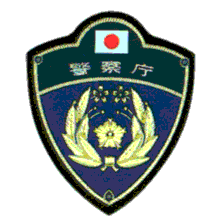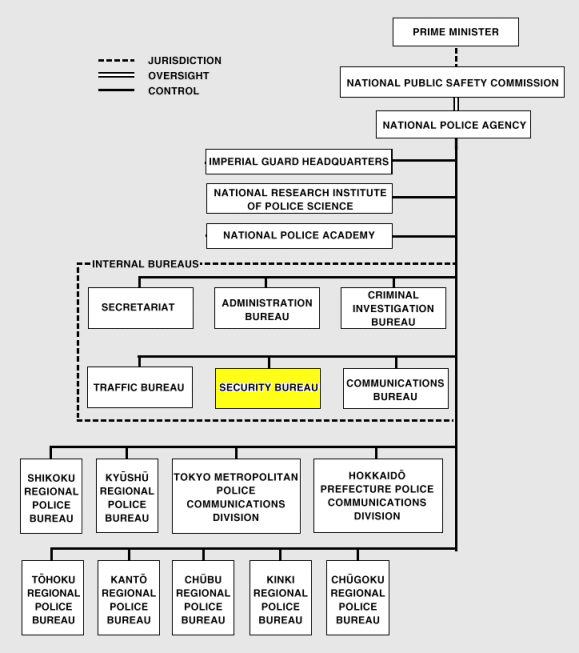





 The Police Law, enacted in 1945, in conforming with principles such as rule of law and local autonomy, aims at providing an efficient police structure on a democratic base. The police structure consists of the national police and the prefectural police. Formerly, most police agencies functioned as guards for the imperial family. Now, there is a mix of centralization and decentralization in that police administration is the responsibility of prefectural governments.
The Police Law, enacted in 1945, in conforming with principles such as rule of law and local autonomy, aims at providing an efficient police structure on a democratic base. The police structure consists of the national police and the prefectural police. Formerly, most police agencies functioned as guards for the imperial family. Now, there is a mix of centralization and decentralization in that police administration is the responsibility of prefectural governments.
The national level police organizations are the National Police Safety Commission (NPSC) and the National Police Agency (NPA). Since the NPSC makes basic policy and the NPA administers police affairs, the NPSC has control over the NPA.
As the central coordinating body for the entire police system, the National Police Agency determines general standards and policies; detailed direction of operations is left to the lower echelons. In a national emergency or large-scale disaster, the agency is authorized to take command of prefectural police forces. In 1989 the agency was composed of about 1,100 national civil servants, empowered to collect information and to formulate and execute national policies. The agency is headed by a commissioner general who is appointed by the National Public Safety Commission with the approval of the prime minister. The central office includes the Secretariat, with divisions for general operations, planning, information, finance, management, and procurement and distribution of police equipment, and five bureaus. The Administration Bureau is concerned with police personnel, education, welfare, training, and unit inspections. The Criminal Investigation Bureau is in charge of research statistics and the investigation of nationally important and international cases. This bureau's Safety Department is responsible for crime prevention, combating juvenile delinquency, and pollution control. In addition, the Criminal Investigation Bureau surveyes, formulates, and recommends legislation on firearms, explosives, food, drugs, and narcotics. The Communications Bureau supervises police communications systems.The NPA maintains Regional Police Bureaus as its local agencies throughout the country. There are seven bureaus in the major cities, excluding Tokyo and the northern island of Hokkaido. Police law stipulates that each prefectural government, which is a local entity, shall have its own Prefectural Police (PP). The PP is supervised by the Prefectural Public Safety Commission, which carries out all police duties within the boundaries of the prefecture. In practice, the PP forces are located in each of the 47 prefectures. The National Police Academy, the National Research Institute of Police Science and the Imperial Guard Headquarters are also organizations affiliated with the NPA.
The National Police Agency has seven regional police bureaus, each responsible for a number of prefectures. Metropolitan Tokyo and the island of Hokkaido are excluded from these regional jurisdictions and are run more autonomously than other local forces, in the case of Tokyo, because of its special urban situation, and of Hokkaido, because of its distinctive geography. The National Police Agency maintains police communications divisions in these two areas to handle any coordination needed between national and local forces.

The Koban system provides local residents with safety and peace through daily contacts of police officers with residents in the area. Its success depends on the human relationship between the police officers and the community people. At times, there is an excess of intervention by police. The Koban system rests on approximately 15,000 police boxes (Hasshusho) and residential police boxes (Chuzaisho) located throughout the country.
The NPA and the PP personnel forces are composed of police officers, officers of the Imperial Guard Headquarters, and civilian employees such as clerical workers and technical engineers. In 1990, there were about 258,800 authorized full-time police personnel. The ratio of police to population is about one officer to 556 citizens. The NPA is comprised of approximately 7,600 personnel, of whom 1,200 are police officers, 900 are Imperial Guards and 5,500 are civilian personnel. The 47 PP forces have a total strength of approximately 250,000, of whom 220,000 are police officers and 30,000 are civilians.
There are two types of police budgets: the national budget and the prefectural budget. The national police budget covers the expenditures of the NPA relevant to the execution of duties under its jurisdiction, including personnel costs, expenses incurred by the prefectural police which are shouldered by the state, and subsidies to the PP. Expenditures needed by the PP to carry out their duties are appropriated in the budget of each prefecture. In 1992, the NPA budget totalled 213,464 billion yen and the PP budget totalled 2,992,454 million yen (270 billion USD). The total National Police Agency Budget for the 1990 fiscal year was 198,420 billion yen, of which 41.5% (82,282 billion yen) went toward personnel expenses, 14.5% (28,870 billion yen) went toward equipment, communications, and facilities, 18.2% (36,149 billion yen) were allocated toward other expenses, and 25.8% (51,119 billion yen) went toward subsidies for Prefectural Police. In all, 74.2% of the total (147,301 billion yen) went toward NPA expenses.The Japanese government established a European-style civil police system in 1874, under the centralized control of the Police Bureau within the Home Ministry, to put down internal disturbances and maintain order during the Meiji Restoration. By the 1880s, the police had developed into a nationwide instrument of government control, providing support for local leaders and enforcing public morality. They acted as general civil administrators, implementing official policies and thereby facilitating unification and modernization. In rural areas especially, the police had great authority and were accorded the same mixture of fear and respect as the village head. Their increasing involvement in political affairs was one of the foundations of the authoritarian state in Japan in the first half of the twentieth century.
The centralized police system steadily acquired responsibilities, until it controlled almost all aspects of daily life, including fire prevention and mediation of labor disputes. The system regulated public health, business, factories, and construction, and it issued permits and licenses. The Peace Preservation Law of 1925 gave police the authority to arrest people for "wrong thoughts." Special Higher Police were created to regulate the content of motion pictures, political meetings, and election campaigns. Military police operating under the army and navy and the justice and home ministries aided the civilian police in limiting proscribed political activity. After the Manchurian Incident of 1931, military police assumed greater authority, leading to friction with their civilian counterparts. After 1937 police directed business activities for the war effort, mobilized labor, and controlled transportation. During the Pacific War (1941-45), the government created the Order Maintenance Law and the Special Police Force to control thought and religion. A considerable number of non-conformists including Individualists and Communists was put into jail until the end of the war.
After Japan's surrender in 1945, occupation authorities retained the prewar police structure until a new system was implemented and the Diet passed the 1947 Police Law. Contrary to Japanese proposals for a strong, centralized force to deal with postwar unrest, the police system was decentralized. About 1,600 independent municipal forces were established in cities, towns, and villages with 5,000 inhabitants or more, and a National Rural Police was organized by prefecture. Civilian control was to be ensured by placing the police under the jurisdiction of public safety commissions controlled by the National Public Safety Commission in the Office of the Prime Minister. The Home Ministry was abolished and replaced by the less powerful Ministry of Home Affairs, and the police were stripped of their responsibility for fire protection, public health, and other administrative duties.
When most of the occupation forces were transferred to Korea in 1950-51, the 75,000 strong National Police Reserve was formed to back up the ordinary police during civil disturbances, and pressure mounted for a centralized system more compatible with Japanese political preferences. The 1947 Police Law was amended in 1951 to allow the municipal police of smaller communities to merge with the National Rural Police. Most chose this arrangement, and by 1954 only about 400 cities, towns, and villages still had their own police forces. Under the 1954 amended Police Law, a final restructuring created an even more centralized system in which local forces were organized by prefectures under a National Police Agency.
The revised Police Law of 1954, still in effect in the 1990s, preserves some strong points of the postwar system, particularly measures ensuring civilian control and political neutrality, while allowing for increased centralization. The National Public Safety Commission system has been retained. State responsibility for maintaining public order has been clarified to include coordination of national and local efforts; centralization of police information, communications, and recordkeeping facilities; and national standards for training, uniforms, pay, rank, and promotion. Rural and municipal forces were abolished and integrated into prefectural forces, which handled basic police matters. Officials and inspectors in various ministries and agencies continue to exercise special police functions assigned to them in the 1947 Police Law.
